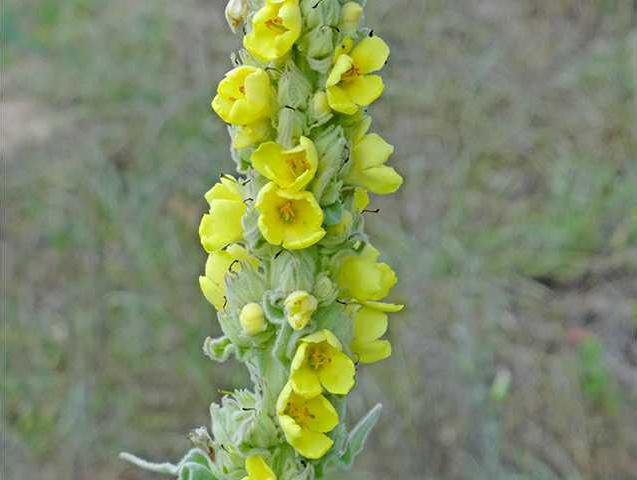Every state has “cowboy toilet paper” growing somewhere in it.
We live in Tattnall County and have several hills of it, and I see it every year. I am sure there are many hills growing in Long and Liberty counties, also. It grows in fields, pastures and along roads. It only grows in the sunshine and lives two years. It does not bloom the first year yet produces a beautiful rosette, and after it blooms, it will gradually die.
But it makes sure that there are seeds to keep it reproducing. Each plant can produce more than 100,000 seeds, which can lie dormant in the soil for 100 years and then grow to a height of 7 feet.
What is this unusual plant that I am writing about? Most people call it mullein. That is what I have always called it. The plants are attractive to me, and I try to point them out to my husband and ask him not to mow them down when he cuts the grass. I put a picture on Facebook of the two that are blooming now, and one man called it wild tobacco. I was about to correct him when I decided that I had better research this plant.
Boy, did I learn a lot. I did not need to correct him after all.
After woods are burned, the mullein plant usually is the first plant to come back. The first year, it just makes a pretty plant. In the second year, a tall shoot or stalk appears from the middle of the plant, covered with hundreds of small yellow flowers that open just a few at the time each day for part of the day. The bees and other insects love them. The stalks get cut off and dipped in wax to make a tall candle. Sometimes, they were covered with animal fat from a roadkill and used as a torch to see at night.
The Romans used the wax-covered stalks for funeral torches. Roman women boiled four tablespoons of dried mullein flowers in a pint of water for 30 minutes and strained it. After shampooing their hair, they brushed it through until they got the golden color they desired. The seeds and flowers contain compounds called saponins, which are soap-like and highly toxic to cold-blooded aquatic creatures. Do not eat mullein seeds! The leaves can be used in salads and are harmless to humans when cooked.
Years ago, some people used to throw mullein in creek water to stun fish and send them floating to the top, making it easy to fill their seines. I have heard of men using a telephone or green walnuts to do this but never mullein leaves. I am sure all of this must be illegal.
According to science writer Becky Lerner, who wrote “First Ways Urban Foraging and Other Wilderness Ways,” there are many surprising uses for mullein. Indians used it hundreds of years ago. One of the best uses they had for mullein leaves was to line the insides of their moccasins — the first insoles. The Navajo used it to cure fevers. The Hopi used it as a cure for insanity. The Iroquois used it to cure hiccups. Modern herbalists regard it as soothing for the lungs. Adding it to smoking mixtures such as lemon balm adds a soft, fluffy texture. The mixture’s leaves are calming when brewed in a tea or when ignited and inhaled. The leaves can be ordered from specialty shops and health stores and a pound of dried leaves are as little as $14.75 per pound. Smoking the dried leaves is one way to bring respiratory medicine directly into your lungs. Mullein is known as a natural diuretic, expectorant, sedative and non-narcotic pain killer. In manufacturing, mullein is used as a flavoring in alcoholic beverages.
The following examples are testimonies from people who used mullein for their ailments. One man had plantar-fasciitis pain. Each morning, he put a leaf of mullein in the heel of his sock and a new one at night. He said it made his feet feel so much better.
One lady who said she had an asthmatic cough for 15 years made tea with three teaspoons of crushed dried leaves in a cup of hot water and steeped it for 30 minutes. She added honey for sweetener and added enough water to make 6 cups. She refrigerated it and drank a half-cup twice a day. Now her 15-year cough is gone.
One person had pneumonia, and the codeine-based cough syrup prescribed by the doctor did not relieve the symptoms. Mullein tea helped, but suppressed his appetite. He made an oil lamp with herb suspended in it and inhaled the smoke and now says he feels almost normal again.
One lady made mullein tea and used it for urinary tract infection and gall-bladder infection. A drop of oil from the flowers is supposed to be good for earache. One person said he used the oil to cure his dog’s ear infection.
By reading all of the above, it seems that the mullein plant should be planted by the acre and doctors prescribing it for any and everything! I, for one, am not even willing to try any of them. I am just content to watch them as they grow and mature in our fields.
The plant has more than 30 names it is known by: grandmother’s flannel, our lady’s flannel, Adam’s flannel, Aaron’s rod, beggar’s blanket, rag paper, fluffweed, woolly mullein and shepherd’s staff are some of the more common. Out West, all the cowboys knew about it and where to find it. They named it “cowboy toilet paper” as the leaves are wide, a light grayish green color, and very soft — softer than corncobs.
Cowboy toilet paper has many uses
Liberty lore


Sign up for our e-newsletters